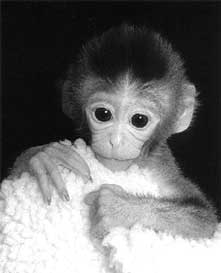Aping each other
 using a technique called embryo-splitting, researchers hope to grow genetically-identical rhesus monkeys in the laboratory. The technique has, so far, produced one living rhesus monkey, a female named Tetra, but Gerald Schatten of the Oregon Health Science University in Portland, usa , said that four more are on the way.
using a technique called embryo-splitting, researchers hope to grow genetically-identical rhesus monkeys in the laboratory. The technique has, so far, produced one living rhesus monkey, a female named Tetra, but Gerald Schatten of the Oregon Health Science University in Portland, usa , said that four more are on the way.
The researchers hope that the breakthrough would enable experiments such as growing new organs from stem cells to be tested on monkeys rather than mice, as monkeys are closer to human biology.
Schatten and his colleagues created monkey embryos in the laboratory by combining sperm and egg. When the embryos grew to an eight-cell stage, they were each split into four parts, with each part containing two cells. These were then nurtured into new embryos.
In effect, the single embryo became four embryos, all genetically-identical. The new embryos were then implanted into the uteri of different mothers.
In the first test, the researchers produced a single animal, named Tetra. A twin to Tetra was implanted, but miscarried.
Now, says Schatten, four monkeys are pregnant with cells taken from two separate embryos. Three of the mothers were implanted with two unrelated embryo splits and the fourth mother was impregnated with a single embryo split. Schatten said it will not be known until May, when the animals are born, which of the split embryos are developing into infants.
"It is likely that we will have genetically-identical monkeys born to different mothers,' he said.
Schatten said the goal is to produce identical monkeys that could be used to perfect new therapies for human disease. Most medical therapies are now first tested in mice, but monkeys would be more reliable in developing daring new techniques such as gene therapy or growing new organs from stem cells, said Schatten.
"It is a huge leap from a mouse to a patient,' said Schatten. "The monkeys could fill that scientific gap.
His research, said Schatten, may make it possible to split a monkey embryo and use one part to produce a live monkey, while using the other embryos parts to produce stem cells. Those stem cells would be genetic matches to the live monkey. The stem cells could then be used to grow new organs, which could then be tested on the live monkey.
For instance, he said, genetically-matched stem cells could be used to grow insulin-producing organs that could then be transplanted into the live monkeys to test a promising technique for curing diabetes.
